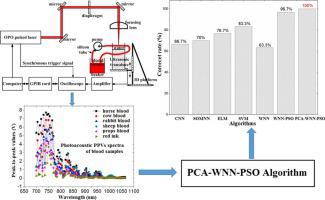Photoacoustics ( IF 7.1 ) Pub Date : 2021-06-01 , DOI: 10.1016/j.pacs.2021.100278 Zhong Ren 1, 2 , Tao Liu 1 , Guodong Liu 1, 2

|
In this work, photoacoustic spectroscopy was employed to distinguish real blood from fake blood rapidly, accurately, and recoverably. To achieve this goal, a photoacoustic detection system for blood was established in the forward mode. In the experiments, four kinds of animal blood and two kinds of fake blood in a total of 150 groups were used. The time-resolved photoacoustic signal and peak-to-peak values (PPVs) of all blood were captured in 700−1064 nm with intervals of 5 nm. Experimental results show that the amplitudes, profiles, peak-point time, and PPVs are different between real and fake blood. Although the PPVs of real blood are larger than those of the fake ones at 700−850 nm, the differences in PPVs are not obvious at 850−1064 nm, especially when there are spectral overlaps of PPVs. To accurately classify and discriminate real and fake blood, a wavelet neural network (WNN) was used to train 120 groups of blood and test 30 groups of blood. Moreover, the particle swarm optimization (PSO) algorithm was used to optimize the weights and thresholds, as well as the translation and scale factors of the Morlet-liked wavelet basis function of the WNN. Under optimal parameters, the correct rate of the WNN-PSO algorithm was improved from 63.3% to 96.7%. Next, principal component analysis (PCA) was combined into the WNN-PSO algorithm to further improve the correct rate. The results indicate that the correct rate of the PCA-WNN-PSO algorithm with 10 principal components reaches 100 %. Therefore, photoacoustic spectroscopy combined with the PCA-WNN-PSO algorithm exhibits excellent performance in the classification and discrimination of real and fake blood.
中文翻译:

基于光声光谱结合粒子群优化小波神经网络的真假血液分类判别
在这项工作中,光声光谱技术被用来快速、准确、可恢复地区分真血和假血。为了实现这一目标,建立了前向模式的血液光声检测系统。实验中使用了四种动物血液和两种假血,共150组。所有血液的时间分辨光声信号和峰峰值(PPV)均在 700−1064 nm 范围内捕获,间隔为 5 nm。实验结果表明,真血和假血的振幅、轮廓、峰点时间和 PPV 不同。虽然在 700−850 nm 处真血的 PPV 比假血液大,但在 850−1064 nm 处 PPV 的差异并不明显,特别是当 PPV 存在光谱重叠时。为了准确分类和区分真假血液,使用小波神经网络(WNN)训练了 120 组血液并测试了 30 组血液。此外,使用粒子群优化(PSO)算法来优化WNN的类Morlet小波基函数的权重和阈值以及平移和尺度因子。在最优参数下,WNN-PSO算法的正确率从63.3%提高到96.7%。接下来,将主成分分析(PCA)结合到WNN-PSO算法中,进一步提高正确率。结果表明,10个主成分的PCA-WNN-PSO算法的正确率达到100%。因此,光声光谱结合PCA-WNN-PSO算法在真假血液的分类和判别方面表现出优异的性能。










































 京公网安备 11010802027423号
京公网安备 11010802027423号